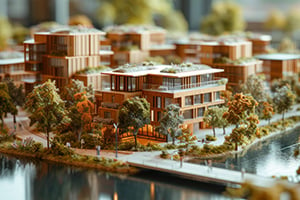 LEED for buildings is well-known and widely recognized as the shape of sustainable architecture to come; more than 1.85 million square feet of new or refurbished structures are certified every single day. But what is LEED for cities, and how does it affect the future of building construction and maintenance in the United States and throughout the world?
LEED for buildings is well-known and widely recognized as the shape of sustainable architecture to come; more than 1.85 million square feet of new or refurbished structures are certified every single day. But what is LEED for cities, and how does it affect the future of building construction and maintenance in the United States and throughout the world?
What is LEED?
LEED, or Leadership in Energy and Environmental Design, is an internationally recognized set of voluntary standards and best practices that govern the construction and maintenance of commercial and residential real estate properties. While voluntary, the trend both in the United States and internationally is a stronger push for buildings to be LEED certified; after all, not only do LEED certified buildings last longer and use their resources more effectively, they frequently save the property managers and owners substantial amounts of capital, as LEED certified buildings use far less water and energy than non-certified buildings by design.
But how does LEED for Cities work?
While ensuring that individual buildings properly steward their water and electricity resources, as well as utilize green building techniques and sustainable engineering best practices, cities themselves have been largely overlooked. All this is changing with the LEED for Cities pilot project. With an intent to encourage cities to track their energy efficiency and sustainability performance in a repeatable, measurable manner, LEED for Cities stands poised to offer a consistent benchmark for sustainable architecture and urban planning on a global scale. Each city that participates in the program is analyzed by groups of highly trained certification professionals, who gauge the effectiveness of the city’s progress towards a more sustainable future. The tremendous benefit of using clear, concise LEED standards is that it is easy for city administrators to know the most important and most straightforward steps they can take to improve a city’s score, and in turn to help their citizens enjoy longer and more prosperous lives.
What benchmarks are included in LEED for Cities?
LEED for cities is focused not only on energy and water usage, but also such wider metrics as equitable distribution of wealth, prosperity, and the general health and safety of the residents. Other categories include transportation, measured in the number of individual vehicles driven daily; education level of the citizens; and median air quality and crime rates. After all, sustainability is not just about the environment: it’s about using modern methods and technologies to make life more sustainable, and that includes a focus on making the citizens healthy, safe, and content. The LEED for Cities pilot standards also heavily reward cities who take a proactive approach to planning for the future, offering additional “points” on the scale out of one hundred for cities which submit conservation, culture and heritage, green infrastructure, and carbon reduction plans, among others.
What if I have more questions?
You’ve come to the right place! Sustainable Investment Group (SIG) is a team of highly trained professionals dedicated to teaching, promoting, and consulting about LEED. Our three primary services–LEED Exam Prep Training, Engineering Services and LEED Consulting–offer us the perfect opportunity to educate business owners, property managers, and construction firms about the tremendous benefits of adopting LEED practices in their next projects. We are so passionate about the benefits of LEED certifications that we are willing to travel internationally for consulting, engineering services, and LEED exam prep, and have also taught classes in Hawaii. Check out the rest of our site to learn more about the services we offer, or contact Sustainable Investment Group (SIG) for more information. Green and sustainable architecture is the future; don’t let the advantages pass you by.



